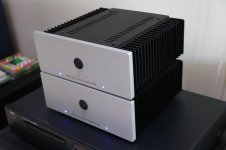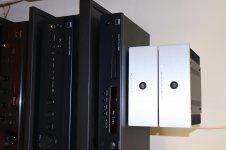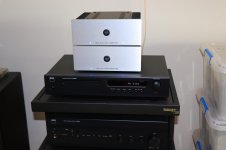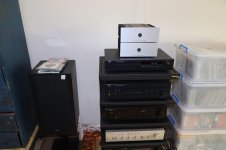Hello to all.
While the boards for the ACA is on the way, I'I decided to think about linear power supply.
This is new to me, and the more I read the more questions.
Can someone please clarify this for me.
I found this option on diyaudioprojects.com

Which transformer is better to choose for this setting?
I looked at 18v 3A (1 channel), but PSUD shows only ~22V at a 2A load.
I already have two chokes Hammond 159zj.
Which way is better one СLCLC to two channels or CLC for each? I'm also interested in the value of the second cap an increase to 15000uF reduces pulsation a little.
This is critical for ACA ?
Thanks for the answers.
While the boards for the ACA is on the way, I'I decided to think about linear power supply.
This is new to me, and the more I read the more questions.
Can someone please clarify this for me.
I found this option on diyaudioprojects.com

Which transformer is better to choose for this setting?
I looked at 18v 3A (1 channel), but PSUD shows only ~22V at a 2A load.
I already have two chokes Hammond 159zj.
Which way is better one СLCLC to two channels or CLC for each? I'm also interested in the value of the second cap an increase to 15000uF reduces pulsation a little.
This is critical for ACA ?
Thanks for the answers.
Never mind, I figured it had to common to both channels. I had reversed pos/neg speaker outputs, So much talk of positive being negative that I didn't see that the circuit card to speaker terminals were positive to positive and negative to negative. All is good now. Clean and powerful output to the Klipish Cornwalls.
Hello to all.
While the boards for the ACA is on the way, I'I decided to think about linear power supply.
...
Which transformer is better to choose for this setting?
I looked at 18v 3A (1 channel), but PSUD shows only ~22V at a 2A load.
I already have two chokes Hammond 159zj.
Which way is better one СLCLC to two channels or CLC for each? I'm also interested in the value of the second cap an increase to 15000uF reduces pulsation a little.
This is critical for ACA ?
Thanks for the answers.
If you are more interested in building a linear power supply than using the readily available and great-sounding 24V SMPS, then you will need to work a little harder. ;-)
Since the ACA is known to perform better with 24V power, then it would be best to choose a 200VA transformer with 2x 20V secondaries. With this option, you can build a quasi dual-mono supply. Use one of the secondary windings for each channel with its own CLC filter. Preferably 15,000 uF caps on either side of the 10 mH inductor.
This will be critical for your ACA, since you do not plan to use a regulator after the CLC filter. The ACA sounds best with minimal ripple on its power.
I have been using ACA as headphone amp for years. I do use two resistors on the output to bring the level down, just like you would on tube amp. The headphone jack and resistors are in small separate box with just two wires going to ACA speakers output. I switched the live and ground though.
Sound is heavenly.
Pictures of your diy Pass amplifier
What are you using for your ACA PSU with headphones? Are the SMPS quiet enough?
ACA mono blocks: An excellent project with a nice result!
I finished the ACA mono blocks some time ago and listen to them daily through an NAD C546BEE CD player with Wolfson 24-bit DAC and the pre-amp section of an NAD C356BEE integrated amp, and a pair of old Sony SS-B5 ES 3-way 4 ohm speakers and it sounds excellent! I have the NAD pre-amp on not more than one-quarters of the volume and it is loud enough. The blue LEDs fit nicely with those of the ACAs'.
The ACAs are a toasty 53 degrees Centigrade in an ambient 25 degrees.
I just wonder if the bottom ACA does not heat up the top ACA too much if you stack them on top of each other as I do.
An excellent project with a nice result!
I finished the ACA mono blocks some time ago and listen to them daily through an NAD C546BEE CD player with Wolfson 24-bit DAC and the pre-amp section of an NAD C356BEE integrated amp, and a pair of old Sony SS-B5 ES 3-way 4 ohm speakers and it sounds excellent! I have the NAD pre-amp on not more than one-quarters of the volume and it is loud enough. The blue LEDs fit nicely with those of the ACAs'.
The ACAs are a toasty 53 degrees Centigrade in an ambient 25 degrees.
I just wonder if the bottom ACA does not heat up the top ACA too much if you stack them on top of each other as I do.
An excellent project with a nice result!
Attachments
Last edited:
Yes, I think the IPP600 is special in the ACA, but you are right at the frontier there. To avoid fatal problems, usual prevention steps are :
1. use appropriate gate stopper resistor, in your case I think should be at least 680 for R15, M3 should be more stable due to R10 shunting from drain to gate.
2. operate at reasonable temperature
3. use RC shunt as per Paul Bysouth on M4 if the above steps are deemed insufficient
But there is also a chance that the IPP600 is inherently stable as is.
There is also other options such as a CFP gain stage that I try in simulation attached that also needs >820 ohm gate resistor R3 to counter a peak at ~2MHz. However, mosfets used are regulars of Pass Labs production, no unexpected nasties.
Hi Indra1, thanks for your post. It raises some very interesting points.
I have been playing with the circuit in spice with all the measures you suggest and with 330p + 1000ohms gate to drain both o/p MFs & 470R gate stopper for M3 & a 4.7K/470p i/p filter this circuit is indeed very stable even with a 1uH choke on the o/p & 1uF across the 8ohm load.
Trouble is, now the -3db HF roll off is now in the sub 60Khz region and I know from experience that I much prefer this to be in the 120Khz region.
For me this raises a very interesting question: Do DIY amplifiers, built for our own use, connected to known loads, have to be stable into any load ? Making amps that are stable into any load is important if selling them to the unknowing public and professional designers correctly regard this as a condition of a finished design but do we think that this also applies to us ?
I think it is important that home made amps are stable enough so they do not spontaneously self destruct but beyond this I think we have the freedom to design our amps so that they are stable with the leads / speakers they are intended for but not necessarily for hypothetical extremely reactive loads. With this & other amps I think this gives us DIYers an advantage over commercially available gear.
I have lots of work to do on my amps before I will regard them at optimised - but even at present to my ears they are the most honest sounding amps I have heard and give insights to the tonal texture of the music that I have not heard before.
For me it would be a pity to lose this transparency for the sake of unnecessary unconditional stability.
mike
Last edited:
I am amazed at how quiet and excellent the ACAs sound with the SMPS. I was looking into building a linear supply for them a while back, but when listening, I can't discern anything wrong that would justify the work and expense.
On the scope I could just notice that linear supplies were slightly cleaner that the supplied SMPSs so I suspect that a well designed, regulated supply will be marginally better - but I do agree that the supplied SMPSs are very good.
Agreed, and it is difficult to predict what will happen as you are truly at the frontier there. As I said, the IPP600 could be good as it is. And your speakers should survive in the event that the IPP600 self destruct protected by the output capacitor. Please do as you see fit.... For me it would be a pity to lose this transparency for the sake of unnecessary unconditional stability.
Agreed, and it is difficult to predict what will happen as you are truly at the frontier there. As I said, the IPP600 could be good as it is. And your speakers should survive in the event that the IPP600 self destruct protected by the output capacitor. Please do as you see fit.
Yes, But just to make it clear about the IPP600, I think they do need some extra protection. I will experiment and post back here when I know more.
Sure, taller feet might help. Get some AIR in there.
Who ever suggested longer low level leads with amps near the speakers?
That's what I do now. But if distances are too much? That kind of pins you down.
Also? Who ever suggested getting the amps OFF the CD player? Also a good move. I hadn't seen that.
Who ever suggested longer low level leads with amps near the speakers?
That's what I do now. But if distances are too much? That kind of pins you down.
Also? Who ever suggested getting the amps OFF the CD player? Also a good move. I hadn't seen that.
leonski66, if you are going to have long leads to the amps and short leads amp to speaker, please make sure the cables used for the long leads are properly shielded and grounded. Suggest checking out suppliers of professional cables for the music business (performances,etc), for ideas.
You gound the single ended wires it at both ends. Balanced is much much better for long runs as you know but it requires balanced outputs. Single end, not shielded or grounded, will acquire all kinds of hum and junk on long runs. You can try single end runs, not shielded or balanced, with cable that based upon many small conductors woven in a way that will result in self cancelling of the noise and junk. I think the name of this is "list cables" or something similar.
- Home
- Amplifiers
- Pass Labs
- Amp Camp Amp - ACA



